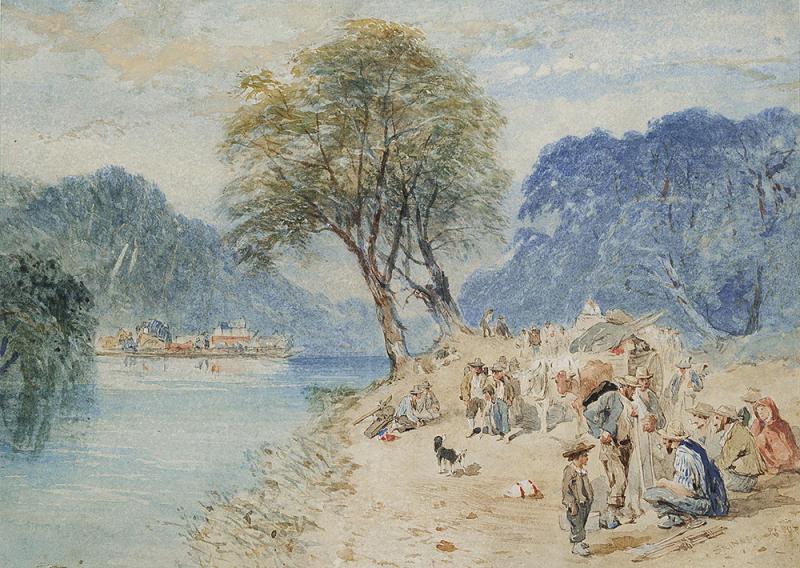JOHN SKINNER PROUT (1805-1876)
Diggers on the Road to a Rush
Estimate: $20000 - 25000
Sold For:
$18,000 hammer
Description
JOHN SKINNER PROUT (1805-1876)
Diggers on the Road to a Rush
watercolour and bodycolour on card
27.0 x 38.0 cm
signed lower right: SKINNER PROUT
Provenance:
Christie’s, London, 22 September 2010, lot 38
Lauraine Diggins Fine Art, Melbourne (label attached verso)
Private collection, Melbourne
Related Works:
NOTE: This item is sold together with a an engraving of the same name:
Godfrey, J., and Prout, J.S., Diggers on the Road to a Rush, steel engraving,19.5 x 26.5 cm, from Booth, E.C., Australia, Virtue & Co, London, 1874, vol 5 (illus.)
Estimate: $20000 - 25000
Result Hammer: $18,000
John Skinner Prout was born in Plymouth England in 1805, and despite residing in Australia for less than a decade, is widely recognised as one of Australia’s most important colonial artists.
Following financial hardship, Prout emigrated to Australia in 1840 accompanied by his wife Maria, their seven children and his lithographic press. During his eight year sojourn, Prout’s artistic abilities were predominantly focused on capturing the unique qualities of the Antipodean light and landscape across numerous pencil drawings, watercolours, oils and lithographs. Other works within his oeuvre such as Diggers on the Road to a Rush, provide a fascinating glimpse of life during the formative years of the colony and were revelatory for audiences in England. Many were curious to hear news from the exotic and embryonic colony, with a view to possibly undertaking the arduous journey to Australia themselves one day in the hope of making their fortune.
Prout was acutely aware of this heightened interest in the life of the digger from his fellow countrymen and in 1852 released a book titled ‘An illustrated handbook of the voyage to Australia and a visit to the gold fields’. In it, he contended that ‘among the various topics which interest the public mind in the present day, there perhaps is not one so deeply important as the subject of our Australian colonies, and their recently discovered gold fields.’1 In the handbook he recalls a scene which could easily describe the scene in Diggers on the Road to a Rush:
Passing over the country between this and the gold fields, we shall take a peep at the busy scenes on the road to the diggings. What a motley crew we have here, men, women, and children, bullock drays and omnibuses, masters and their former servants, some on horseback, others trudging along under the weight of their necessary tools and implements, and the overpowering effects of an almost tropical sun; but now they rest awhile and enjoy their roadside repast, and when the evening sets in, and the forest tracks are no longer visible… horses and bullocks are tethered and turned into the bush.2
Completed with such assured handling, Diggers on the Road to a Rush exemplifies Prout’s readiness to employ a degree of looseness and artistic license to carry the mood of the picture, as opposed to the prevalent pro-occupation for many of his contemporaries such as Benjamin Duterreau and John Glover with recording the most minute of details. There is an annotation verso by Prout, ‘painted from sketches made on the spot’, which supports the belief that Diggers on the Road to a Rush is infact a composite view of the many sketches the artist undertook during his travels through New South Wales, Van Dieman’s Land (now Tasmania) including Flinders Island and the Port Phillip District of New South Wales (now Victoria). The work reveals Prout’s masterful and largely self-taught technical skills while exploring the fashionable subject matter du jour, the gold rush, for prospective emigrants. It should come as little surprise that Diggers on the Road to a Rush was one of only five key works selected to be translated into an etching plate for reproduction in Edwin Carton Booth’s important publication Australia, published in London in 1874.
Footnotes
1. Prout, J.S., An illustrated handbook of the voyage to Australia and a visit to the gold fields: descriptive of the new moving panorama exhibiting daily at 309 Regent Street, Petter, Duff and Co., London, 1852, Preface, p.v.
2. Ibid, p.24
Marina Brennan BA (Hons)
Location
SYDNEY VIEWING. 17 - 20 October 11am - 6pm. 12 Todman Avenue, Kensington
MELBOURNE VIEWING. 24 - 30 October 11am - 6pm. Stonnington Mansion, 336 Glenferrie Rd, Malvern
